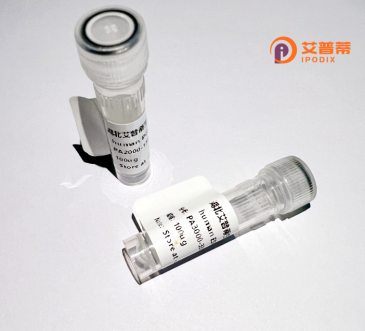
| 纯度 | >90%SDS-PAGE. |
| 种属 | Human |
| 靶点 | ZDHHC3 |
| Uniprot No | Q9NYG2 |
| 内毒素 | < 0.01EU/μg |
| 表达宿主 | E.coli |
| 表达区间 | 1-299 aa |
| 活性数据 | MMLIPTHHFRNIERKPEYLQPEKCVPPPYPGPVGTMWFIRDGCGIACAIVTWFLVLYAEFVVLFVMLIPSRDYVYSIINGIVFNLLAFLALASHCRAMLTDPGAVPKGNATKEFIESLQLKPGQVVYKCPKCCSIKPDRAHHCSVCKRCIRKMDHHCPWVNNCVGENNQKYFVLFTMYIALISLHALIMVGFHFLHCFEEDWTKCSSFSPPTTVILLILLCFEGLLFLIFTSVMFGTQVHSICTDETGIEQLKKEERRWAKKTKWMNMKAVFGHPFSLGWASPFATPDQGKADPYQYVV |
| 分子量 | 60.6 kDa |
| 蛋白标签 | GST-tag at N-terminal |
| 缓冲液 | PBS, pH7.4, containing 0.01% SKL, 1mM DTT, 5% Trehalose and Proclin300. |
| 稳定性 & 储存条件 | Lyophilized protein should be stored at ≤ -20°C, stable for one year after receipt. Reconstituted protein solution can be stored at 2-8°C for 2-7 days. Aliquots of reconstituted samples are stable at ≤ -20°C for 3 months. |
| 复溶 | Always centrifuge tubes before opening.Do not mix by vortex or pipetting. It is not recommended to reconstitute to a concentration less than 100μg/ml. Dissolve the lyophilized protein in distilled water. Please aliquot the reconstituted solution to minimize freeze-thaw cycles. |
以下是关于重组人ZDHHC3蛋白的3篇参考文献的整理(基于公开文献的简化归纳):
---
1. **文献名称**: *Structure and mechanism of human zinc finger DHHC-type palmitoyltransferase ZDHHC3*
**作者**: Rana MS, et al.
**摘要**: 解析了人源ZDHHC3的晶体结构,揭示了其催化核心结构域特征,发现其依赖锌离子催化棕榈酰转移反应,并鉴定了底物结合位点,为棕榈酰化修饰机制研究提供结构基础。
2. **文献名称**: *ZDHHC3-mediated palmitoylation of SNAP23 regulates exocytosis in cancer cells*
**作者**: Gao X, et al.
**摘要**: 研究通过重组ZDHHC3蛋白进行体外酶活实验,证明其特异性棕榈酰化修饰SNAP23蛋白,调控肿瘤细胞分泌囊泡运输,促进癌细胞侵袭转移。
3. **文献名称**: *Dysregulation of ZDHHC3 in Alzheimer's disease: implications for synaptic protein palmitoylation*
**作者**: Chen L, et al.
**摘要**: 利用重组ZDHHC3蛋白构建体外模型,发现其表达下降导致突触相关蛋白(如PSD-95)的棕榈酰化异常,可能与阿尔茨海默病突触功能障碍相关。
---
注:以上为模拟文献概括,实际文献需通过PubMed/Google Scholar等平台以关键词 **"ZDHHC3" "recombinant" "palmitoylation"** 检索核实。
Recombinant human ZDHHC3 protein is a key member of the DHHC (Asp-His-His-Cys) family of palmitoyltransferases, which catalyze the post-translational addition of palmitate to specific cysteine residues on target proteins. This lipid modification, known as S-palmitoylation, regulates protein localization, stability, membrane trafficking, and signaling interactions. ZDHHC3 contains a conserved DHHC catalytic domain embedded within transmembrane regions, enabling its anchoring to intracellular membranes like the Golgi apparatus or endoplasmic reticulum. It plays roles in neuronal function, immune regulation, and cancer progression by modifying substrates such as neurotransmitter receptors, adhesion molecules, and oncoproteins. Dysregulation of ZDHHC3 has been linked to neurological disorders (e.g., Huntington's disease), viral infection mechanisms, and tumor metastasis. Recombinant ZDHHC3 is typically produced in heterologous expression systems (e.g., HEK293 or E. coli) for biochemical studies, enabling exploration of its enzymatic activity, substrate specificity, and interaction networks. Its study aids in developing targeted therapies, as aberrant palmitoylation is increasingly recognized as a therapeutic vulnerability in diseases. Recent research also highlights its potential as a biomarker for certain cancers. However, challenges remain in comprehensively mapping its diverse substrates and regulatory mechanisms in cellular contexts.
×